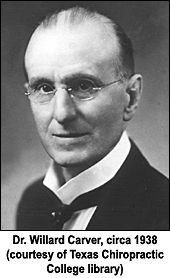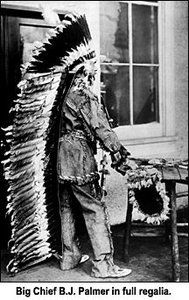Recent laws in New Jersey and California represent a disturbing trend that will negatively impact a practice’s ability to collect monies from patients, as well as expose them to significant penalties if the practice does not follow the mandatory guidelines to a T. Please be aware that a similar law may be coming to your state. The time to act is before the law is passed.
Carver College: An Oklahoma Contribution to Chiropractic (Part 2 of 2)
| Editor's note: Part 1 of this article appeared in the Nov. 18, 2004 issue. |
Like many early chiropractic schools, Carver College was a family affair, and many of Willard's relatives served as faculty members and administrators. Most prominent among these was 1909 alumnus Fred J. Carver, DC, Willard's younger brother. However, following a dispute with Willard, Fred relocated to Wichita, where he developed a thriving practice and became noted for his "Postural Technique." Dr. Fred Carver passed away in 1947.



Tom Lawrence, DC, a 1938 graduate of the Oklahoma City school, recalls his experiences at Carver College when he arrived in 1936:
| When we arrived at 521 W. 9th St. in Oklahoma City, Okla., we received a mild shock. It was unlike any college campus we had ever seen. Three buildings made up the campus. A two-story brick building, which was previously a church, had an auditorium on the second floor and Dr. Carver's office and other administrative offices on the first floor. A two-story frame building, adjacent to the brick building and also facing 9th St., had classrooms on the second floor and the ground floor served as the clinic. A third building at the back of the lot had half a dozen dormitory rooms. I consider the faculty to have been competent and capable. Dr. Clora Norris, a recent graduate, was an anatomy instructor. She was quite knowledgeable and an excellent teacher. Dr. Willard Carver's son, Dr. Ronald Carver, was Technique Instructor and Clinic Director. Other faculty members were Dr. Frank Brooks, Dr. Bera Smith, Dr. Sturdivant and Dr. Sowell. There were many others whose names I cannot recall. Oftentimes, a doctor in private practice or a visiting dignitary from the field of education would lecture to us. I remember several lectures were presented by John Hubbard, MD, DC, who owned and operated Hubbard Hospital, located a few blocks from the college. Drs. Hubbard and Carver were friends and respected each other. Dr. Carver many times recommended circumcision for patients, both male and female. Those patients were referred to Dr. Hubbard for the surgery. Dr. Carver lectured frequently, always in the auditorium and to the student body. He was a great public speaker. He had a strong, resonant, deep toned voice with meticulous enunciation and a convincing demeanor. I followed his every word. I am not sure now if it was because I felt that I should pay attention or if it was because I was afraid not to. He spent a lot of time delineating the problems of the profession, and outlining his recommendations for what should be done to alter the flow of events and to correct the flaws in the philosophy, art and practice, of chiropractic. His favorite target for criticism and invective was Dr. B.J. Palmer.9 |






Dr. Willard Carver was an early supporter of the American Chiropractic Association (ACA) of the 1920s and its successor, the National Chiropractic Association (NCA).5 As well, he was a decades-long opponent of B.J. Palmer, DC, with whom he feuded in the pages of their college periodicals. Carver inspired the formation of the ACA's council for college leaders circa 1928, and supported similar efforts by the International Chiropractic Congress of the late 1920s and early 1930s. However, following the NCA's formation of its Committee on Education in 1935, and the committee's collaboration with the Council on State Chiropractic Examining Boards (today's FCLB) to upgrade chiropractic education, Carver had second thoughts. He prompted the 1939 formation of the Allied Chiropractic Educational Institutions (ACEI), a successor to the Associated Chiropractic Colleges of America (ACCA).
Like the ACCA, the ACEI was comprised of straight chiropractic schools (Cleveland, Eastern Palmer, Ratledge, Texas) whose leaders saw the NCA initiatives as an effort to "medicalize" chiropractic.7 With the nation in the midst of the Great Depression, these "schoolmen" (and some from the broad-scope side of the profession) also strenuously objected to what they viewed as unjustified interference with their businesses (unique among the ACEI schools, the Cleveland College of Kansas City was a nonprofit corporation). Carver and Palmer apparently found sufficient ground here to set aside their long feud and work together against the NCA. Their plight would be further aggravated by the onset of World War II, with its resulting depletion of student bodies.
After Willard's death in 1943, the Carver Chiropractic College would wander in and out of alliance with the NCA's Council on Education (today's CCE). However, with declining enrollments in the mid-1950s, the 52-year-old Oklahoma City institution was forced to close its doors in 1958, when it merged with the Logan Basic College of Chiropractic in St. Louis. But that is a story for another day.
References (for parts 1 and 2)
- Carver, Willard. History of Chiropractic, unpublished, circa 1936 (Palmer West archives; available in Microsoft Word from the author: jckeating@aol.com).
- Carver, Willard. Letter to D.D. Palmer, 15 February 1905; reproduced in the Journal of the National Chiropractic Association 1958 (Oct);28(10):9-10,52,54.
- Gielow, Vern. Old Dad Chiro: A Biography of D.D. Palmer, Founder of Chiropractic. Davenport IA: Bawden Bros., 1981.
- Jackson, Robert B. Willard Carver, LL.B., D.C., 1866-1943: doctor, lawyer, Indian chief, prisoner and more. Chiropractic History 1994 (Dec);14(2):12-20.
- Keating, Joseph C. The short life and enduring influence of the American Chiropractic Association, 1922-1930. Chiropractic History 1996 (June);16(1):50-64.
- Keating, Joseph C. Several pathways in the evolution of chiropractic manipulation. Journal of Manipulative & Physiological Therapeutics 2003a (June);26(5):300-21.
- Keating, Joseph C. Before Nugent took charge: early efforts to reform chiropractic education, 1919-1941. Journal of the Canadian Chiropractic Association 2003b (Sept);47(3):180-216.
- Keating, Joseph C.; Brown, Richard A.; Smallie, Paul. Tullius de Florence Ratledge: The missionary of straight chiropractic in California. Chiropractic History 1991 (Dec);11(2):26-38.
- Lawrence, Thomas. E-mail to J.C. Keating, 7 August 2002.
- Levine, Mortimer. The Structural Approach to Chiropractic. New York: Comet Press, 1964.
- Montgomery, D. Patrick; Nelson, J. Marlene. Evolution of chiropractic theories of practice and spinal adjustment. Chiropractic History 1985;5:70-6.
- Ratledge, T.F. Letter to William Randolph Hearst, 20 June 1916 (Ratledge papers, Cleveland Chiropractic College of Kansas City).
- Rosenthal, Melvin J. The structural approach to chiropractic: from Willard Carver to present practice. Chiropractic History 1981;1:25-8.
- Zarbuck, Mervyn V. Chiropractic parallax. Part 2. IPSCA Journal of Chiropractic 1988d (Oct);9(4):4-6,17.
Joseph Keating Jr., PhD
Phoenix Arizona
jckeating@aol.com



